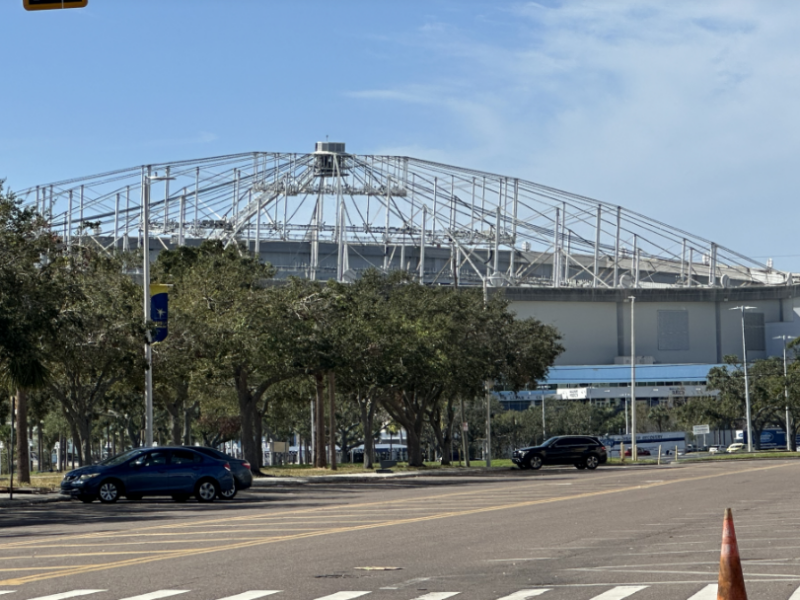Pictured Above: The St. Petersburg campus’ positive COVID-19 cases have remained low since Jan. 3, according to the university’s COVID-19 dashboard.
Baron Reichenbach | The Crow’s Nest
By Mark Parker
With COVID-19 cases in the state and nation rising to levels not seen since the summer, many students and faculty at USF St. Petersburg were worried that with the extended time off and holidays that usually revolve around visiting family and friends, there would be a spike in cases when we returned in January.
While there was an increase in student cases, the numbers quickly fell. Faculty cases remained mostly unchanged.
According to the USF COVID-19 dashboard, for the week beginning Nov. 15, only one student at USF St. Petersburg tested positive. The Tampa campus recorded 24 students and the Sarasota-Manatee campus recorded none.
The dashboard also said that when students began to return to campus the week beginning Jan. 3, USF St. Petersburg saw its numbers increase to eight students, while Tampa and Sarasota-Manatee increased to 82 and three, respectively.
Dean of Students Jacob Diaz said despite these numbers, students “did a good job during the break.”
He said that low numbers may be “good signs that the mitigation tactics are working.”
University numbers have continued to fall sharply, even after Super Bowl celebrations.
The week beginning on Jan. 31 and ending on Super Bowl Sunday saw USF St. Petersburg recording four positive cases, with 41 in Tampa and none in Sarasota-Manatee. Two weeks after the Super Bowl, the number of cases has fallen to zero for USF St. Petersburg, zero for Sarasota-Manatee and five for Tampa.
Numbers are down and vaccinations are up in St. Petersburg, as well. On Feb. 17, St. Petersburg Mayor Rick Kriseman tweeted that the city is back down in the 5 percent positive range for a two-week average. According to Kriseman, 112,000 people in the county have already been vaccinated.
“There is sunlight, folks,” Kriseman wrote.
Despite progress, tangible changes to campus life have yet to be realized.
The university is currently under “Phase Two,” which allows for 50 percent of students and faculty to be on campus, yet most students still take all of their classes online. Masks are still mandated both inside and outside on-campus, and campus visitors are still expected to maintain six feet of social distance.
“If you would have said 12 months ago that we would be having the same conversation 12 months from now, I would have said: ‘Really? No way.’ Yet here we are,” Diaz said.
While Diaz expects the summer semester to carry on like the spring, he is hoping that the fall semester will bring back a sense of normalcy. However, he said that no decisions on changing current protocols have been made. He stressed a fluid situation and a desire to err on the side of caution.
In Pinellas County, health care workers and those over 65 are receiving COVID-19 vaccines. Diaz said that there have been no conversations with the state government on when college students and faculty would be able to receive the vaccine.
While many students are anxious for a return to normalcy, others have brought up a potential drawback: After a year of doing everything online, a sudden switch to being back in-person would disrupt schedules that some are just getting used to.
“I am so used to everything being online now that going back to face-to-face would really mess up my schedule,” Isabella Straub, a senior mass communications major, said. “I just started a new internship and I’m not sure if I would be able to do both.”
Straub still hopes for an open graduation in December.
For people in similar situations as Straub’s, graduation takes on an even greater importance.
Her mom was seriously ill when she graduated high school and could not attend that graduation.
“It should be far enough away that we can bring a couple family members, I hope,” she said.
The federal government is expected to pass a new $1.9 trillion stimulus bill soon. This includes billions of dollars for schools, and USF is already putting together a new application for students in need to receive additional grants.
“I think it will help,” Diaz said. “We are really trying to keep everyone in school.”
Diaz echoed what he stressed to students in November.
“Stay the course; keep doing what we are doing,” he said. “Good results come with what you pay attention to.”



